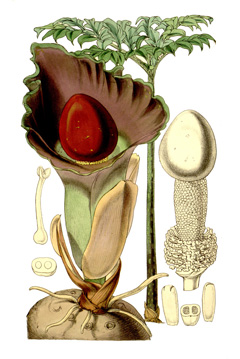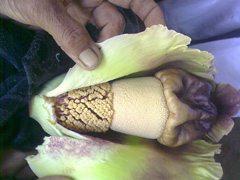 |
|
https://edibleplants.org/ |
 |
|
Translate this page:
Summary
Physical Characteristics

 Amorphophallus paeoniifolius is a PERENNIAL growing to 0.8 m (2ft 7in).
Amorphophallus paeoniifolius is a PERENNIAL growing to 0.8 m (2ft 7in).
See above for USDA hardiness. It is hardy to UK zone 10. The species is monoecious (individual flowers are either male or female, but both sexes can be found on the same plant) and is pollinated by Flies.
Suitable for: light (sandy) and medium (loamy) soils. Suitable pH: mildly acid, neutral and basic (mildly alkaline) soils. It can grow in semi-shade (light woodland) or no shade. It prefers moist soil.
UK Hardiness Map
US Hardiness Map
Synonyms
A. campanulatus. (Roxb.)Blume.
Plant Habitats
Woodland Garden Dappled Shade; Cultivated Beds;
Edible Uses
Edible Parts: Leaves Root
Edible Uses:
Corm - cooked[2
, 4
, 103
, 105
]. Acrid raw[2
], it must be thoroughly boiled or baked (see notes above on 'Known Hazards'[K
])[46
, 61
]. A very large root, it can be up to 50cm in diameter[200
, 243
, 266
]. Corms are usually harvested when three years old, at this stage they can weigh up to 9kg[300
]. The corms can be stored for several months at 10°c[300
]. Some caution is advised, see notes above on toxicity. The fresh corms are turned into curd, or are chopped then dried[472
]. The curd is relatively tasteless, but it absorbs flavours well and so can be used as a carbohydrate element in a wide range of other foods[472
].
Young leaves and petioles - cooked and used as a vegetable[300
]. They must be thoroughly cooked[105
, 183
]. Caution is advised, see notes above on possible toxicity.
References More on Edible Uses
Medicinal Uses
Plants For A Future can not take any responsibility for any adverse effects from the use of plants. Always seek advice from a professional before using a plant medicinally.
Carminative Dysentery Expectorant Restorative Stomachic Tonic
The root is carminative, restorative, stomachic and tonic[240, 243]. It is dried and used in the treatment of piles and dysentery[240, 243]. The fresh root acts as an acrid stimulant and expectorant, it is much used in India in the treatment of acute rheumatism[240, 243]. Some caution is advised, see the notes above on toxicity.
References More on Medicinal Uses
The Bookshop: Edible Plant Books
Our Latest books on Perennial Plants For Food Forests and Permaculture Gardens in paperback or digital formats.

Edible Tropical Plants
Food Forest Plants for Hotter Conditions: 250+ Plants For Tropical Food Forests & Permaculture Gardens.
More

Edible Temperate Plants
Plants for Your Food Forest: 500 Plants for Temperate Food Forests & Permaculture Gardens.
More

More Books
PFAF have eight books available in paperback and digital formats. Browse the shop for more information.
Shop Now
Other Uses
Plants are often grown as an understorey crop in woodlands or in plantations of betel (Areca spp.), coconuts (Cocos nucifera), bananas (Musa spp.) or coffee (Coffea spp.)[472
].
Special Uses
Scented Plants
References More on Other Uses
Cultivation details
A temperature in the range of 25 - 35°c is required with an annual rainfall of 1,000 - 1,500mm[300
]. Corm development is promoted during dry periods[300
].
The best crops are produced on deep, fertile, alluvial soils that are slightly acid[300
]. Dislikes heavy clay soils[300
]. Plants require some shade, especially when young[300
]. Members of this genus generally require a moist but well-drained, humus-rich, fertile soil and a position in dappled shade[472
].
The plants are usually grown on a three year cycle[300
]. An interesting technique used in Indonesia is to dig up the tuber after one year and then replant it upside down. This stimulates the lateral buds into growth and increases the overall size of the tuber[472
].
Yields of 20 tonnes per hectare can be achieved[300
].
There are many cultivated forms, some of which have a lower content of calcium oxalate crystals and less or no alkaloids[472
].
The plant produces one or two enormous leaves and one short flowering stem annually. When ripe for pollination, the flowers have a foetid smell to attract carrion flies and midges. This smell disappears once the flowers have been pollinated[245
].
Like many species in the family Araceae, this plant has the ability to heat the flowering spadix as the pollen becomes ready for fertilization. This heat greatly increases the strength of the aroma released by the plant, thus attracting more pollinating insects. It can also have the effect of making the insects more active, thus increasing the level of fertilization[472
].
References Carbon Farming Information and Carbon Sequestration Information
Temperature Converter
Type a value in the Celsius field to convert the value to Fahrenheit:
Fahrenheit:
The PFAF Bookshop
Plants For A Future have a number of books available in paperback and digital form. Book titles include Edible Plants, Edible Perennials, Edible Trees,Edible Shrubs, Woodland Gardening, and Temperate Food Forest Plants. Our new book is Food Forest Plants For Hotter Conditions (Tropical and Sub-Tropical).
Shop Now
Plant Propagation
Seed - best sown in a pot in a warm greenhouse as soon as it is ripe and the pot sealed in a plastic bag to retain moisture. It usually germinates in 1 - 8 months at 24°c[133]. When large enough to handle, prick the seedlings out into individual pots and grow them on in the greenhouse for at least a couple of years. Plant them out in late spring or early summer, after the last expected frosts, and give them some protection such as a cloche until they are growing away strongly.
Other Names
If available other names are mentioned here
Achung, Arsaghna, Ba-tel-hawng, Badur, Baghraj, Balukand, Bebebikeno, Buk, Chena, Daiga, FiÕi Andoi, Hakai, Hita, Iles-iles, Jimmikand, Kanda, Karnai-kilangu, Kembang bangah, Keobi, Leba, Loka, Loki, Ol kochu, Ol, Ool, Pungapung, Soa, Soro, Stinking Snakeskin Lily, Suran, Suvarna gadde, Suweg, Talingo potato, Telinga potato, Teve, Ubi kekek, Voodoo lily, Walur, Whitespot giant arum, Zamin-kand.
Native Range
TEMPERATE ASIA: China (south), Taiwan TROPICAL ASIA: Bangladesh, India, Sri Lanka, Papua New Guinea, India (Andaman and Nicobar Islands), Laos, Myanmar, Thailand, Vietnam, Indonesia, Malaysia, Philippines AUSTRALASIA: Australia (Northern Territory (north)) AFRICA: Madagascar
Weed Potential
Right plant wrong place. We are currently updating this section.
Please note that a plant may be invasive in one area but may not in your area so it's worth checking.
None Known
Conservation Status
IUCN Red List of Threatened Plants Status : Least Concern

Growth: S = slow M = medium F = fast. Soil: L = light (sandy) M = medium H = heavy (clay). pH: A = acid N = neutral B = basic (alkaline). Shade: F = full shade S = semi-shade N = no shade. Moisture: D = dry M = Moist We = wet Wa = water.
Now available:
Food Forest Plants for Mediterranean Conditions
350+ Perennial Plants For Mediterranean and Drier Food Forests and Permaculture Gardens.
[Paperback and eBook]
This is the third in Plants For A Future's series of plant guides for food forests tailored to
specific climate zones. Following volumes on temperate and tropical ecosystems, this book focuses
on species suited to Mediterranean conditions—regions with hot, dry summers and cool, wet winters,
often facing the added challenge of climate change.
Read More
Expert comment
Author
(Dennst.)Nicolson.
Botanical References
200266
Links / References
For a list of references used on this page please go here
A special thanks to Ken Fern for some of the information used on this page.
Readers comment